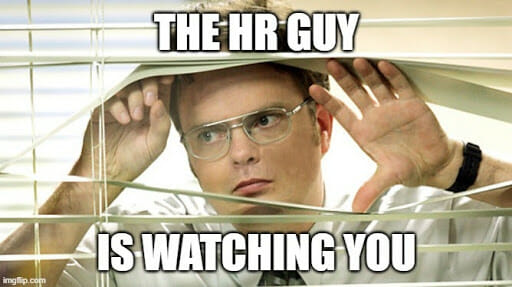HR and AI: Making Human Resources more “Human” with Algorithms

You don’t need to read the title again. That’s exactly what I said: AI could make HR more “human” than before.
Sounds counterintuitive?
Actually yes. We are used to thinking of artificial intelligence as something depersonalizing.
The truth is that AI and its latest evolutions, namely machine learning and deep learning, may positively influence HR management and, consequently, the general well-being of a company’s staff.
Artificial intelligence… and human dimension
How to pay more attention to the human dimension of the work experience?
This can be achieved by AI-based systems in several ways:
-
Helping to attract and hire new talent
-
Employee retention by safeguarding the work environment
-
Employee retention by improving training and mobility
-
Automating administrative tasks
Understood? Machines also have a heart.
And that heart, my friends, is certainly bigger than that of a typical HR manager.
EH EH EH
What does “Human Resources” mean today
If there is a corporate department to meme about, that department is definitely HR.
Hated and respected, feared and courted, human resources managers are an essential cog in any company.
They are basically responsible for any aspect of the employee life cycle, from hiring to terminating a job relation (cute paraphrase for “firing”), not to mention promotions, transferring, and training.
Their duties include recruitment planning, selection process, evaluating the employees’ performances, payroll and benefits administration, and so on.

Why should AI have anything to do with HR?
Considering the responsibilities of HR departments in overseeing a wide range of occupational aspects, it would be natural to see them as priority targets for technological renewals.
Instead, human resources have been slower to reap the potential benefits of artificial intelligence than other fields, such as marketing or communications.
Recently, things have started to change, thanks to the clear and proven potential of algorithms in managing various problems and tasks.
An example? CEOs and HR managers should always know what’s really going on within a company because any information about it helps them point people in the right direction.
Artificial intelligence and machine learning technologies are incomparably superior to humans in handling such a flow of information regarding the company itself and the performance of its staff.
Machine learning and deep learning in HR
As mentioned earlier, AI plays a pivotal role in HR due to its ability to manage data better and faster than humans.
Why?
Well, this “superpower” was first of all unleashed by the latest evolution in artificial intelligence, known as machine learning (ML).
Machine learning is a branch of AI specialized in creating algorithms that can learn from data, recognize patterns, and make predictions about it. All this coolness… without even being specifically programmed to do so!
Think about an algorithm to identify cars from pictures. In this case, the machine will teach itself how a car looks by analyzing thousands of car pics.
The aim of the algorithm, which is to identify cars, has been established by programmers, but the steps to reach this objective will be learned by the machine itself after training on data.
What if we talk about HR?
The same can be done in HR processes. If we feed an ML-based system with data about employees’ education, careers, performances, skill sets, the machine will start to recognize patterns and categorize workers in different archetypes with common traits.
Then, it could understand that specific types of people tend to excel in some tasks and, on the other hand, struggle when facing different issues.
Analyzing and categorizing people through machines might sound a bit dystopian, right?
Maybe yes… but if such processes allow, for example, to provide a more personalized employee experience, using previously collected data and predictive analytics to recommend career paths, why not?
Deep learning and neural networks
A further step has been taken with the development of deep learning, a branch of ML that trains machines to learn from huge amounts of data thanks to artificial neural networks.
These systems are able to recognize the most abstract and mysterious patterns by peering deeply into the data and processing the information through the numerous layers that make up these networks.
DP-based systems are extremely efficient, but also madly hungry for data. To work properly and make predictions and interpretations regarding very complex information, deep learning algorithms require intensive training on large datasets.
DL for speech recognition
Deep learning paves the way for even more surprising innovations in the field of human resources.
First of all, it is an essential tool for speech recognition. Basically, any virtual assistant and chatbot make extensive use of these algorithms to process the human voice and respond accordingly.
This allows companies to automate a variety of HR-related processes and services, making them faster and available around the clock.
No more skeletons sitting in front of a laptop!

Image recognition and behavioral analysis
Another interesting application of DL concerns behavioral analysis and image recognition to identify the mood of employees and spot signs of discomfort.
Consider my case for just a moment. As all my colleagues can testify (I know where their families live) I am an exceptional and hardworking professional and I am also extremely modest.
A DL-powered machine, connected to sensors and cameras, could “study” my usual blameless behavior and recognize some recurring patterns. If these patterns are broken, our system would understand that something is wrong.
This usually happens because I’m hungry and need a chocolate break. But it could be something worse. Something that the management should know in order to offer me some kind of support.
Free chocolate, for example.
1. AI for recruiting
After this brief overview of AI technologies in the HR field, let’s see some practical applications, starting with the very beginning of an employment relationship: the recruiting phase.
Recruiting is one of the most important yet extremely time-consuming duties of HR, especially for companies and jobs that receive high volumes of applicants.
Properly implemented ML technologies can save time and make the entire process more reliable and accurate thanks to predictive analytics.
You can see it in action in the recommending systems of popular ML-powered job search websites like LinkedIn and Indeed. These platforms offer suggestions about potentially suitable candidates by analyzing their connections, posts, searches, and data in general.
ML and job interviews
What about the interviews? Well, an interesting case is that of Unilever, a British-Dutch consumer goods company.
This multinational has implemented ML-based platforms to scan the applications it receives. Each candidate goes through three fully automated interviews and assessments before meeting a human recruiter for the first time.
This system saved more than 50,000 hours of time and reduced the length of the hiring process from 4 months to 4 weeks.
Another way in which AI can optimize the interviewing process is via image and speech analysis.
A deep learning-driven system is able to catch some very specific nuances and spot behavioral patterns (voice tone, muscular contractions…), determining the candidate mood or the veracity of his statements.
It may even detect the interviewee’s murderous instincts, after hearing the recruiter say the company is looking for interns with ten years of experience.
Unilever has implemented ML-based platforms to scan the applications it receives. This system saved more than 50,000 hours of time and reduced the length of the hiring process from 4 months to 4 weeks.

Machines and bias
While human intervention is still necessary to get a proper idea of candidates, machine learning will provide accurate tools that are not affected by the typical human bias.
Machines don’t care about a candidate’s gender, age, the color of the skin, and so on. They are tolerant and inclusive.
Like Death. And Canadians.
2. Employee retention: AI vs harassment
After hiring new talent, retaining them seems like a cool idea, right?
One of the ways to do so is by babysitting protecting the employees from possible conflicts or harassment and ensuring a safe and pleasant work environment.
The identification of attrition risk requires advanced pattern recognition in detecting a wide range of variables and data. Something that machine learning can do faster than any HR manager.
AI to find out the bad guys
Algorithms are able to identify the personnel’s emotional activity, including verbal harassment, by scanning comments, emails, chats, and then offer suggestions to the HR department.
In this regard, speech recognition represents an extraordinary tool unlocked by neural networks for understanding employee mood.
Algorithms can also be applied in the behavioral analysis that we mentioned before. Some guy at the office acts like an asshole with his colleagues, showing behaviors that deviate from the “norm”? Probably machine vision will spot it!
Financial institutions like JPMorgan have even implemented algorithms to probe their staff and identify “dishonest employees” before any criminal activity takes place.

3. Employee retention: training and mobility
Another effective way to retain great employees is to invest in them.
Excluding corporate dinners, which are always welcome if offered by the company (don’t you like to eat for free?), the best investment to motivate an employee is to offer him/her a path of professional growth.
Machine learning already showed its potential in boosting individual skill development, offering platforms that can give personalized guidance and training recommendations even without the necessity of human coaches.
The training programs can be tailored to the specific needs of each employee, taking into account their competencies, careers, the company’s needs, market trends, and many other factors.
What about promotions?
Once employees are properly trained and have successfully demonstrated their skills and performance, AI-based software can evaluate these results and suggest which ones should be promoted.
This means influencing internal mobility without any typical human bias, a problem we have already addressed in the section on recruiting.
So… things like offering coffee to the HR manager will no longer work.
AI to forecast future resignations
However, AI technology is not limited to evaluating promotion possibilities.
It can also predict team members’ discontent (for example with surveys or the previously mentioned behavioral analysis) and consequently their willingness to leave the company.
This allows HR managers to act before it’s too late, setting some retention efforts such as offering additional benefits. Or, once again, a promotion.
4. Algorithms for administrative automation
The last AI application I’d like to talk about was actually one of the first to be implemented in HR: automating administrative and bureaucratic tasks.
Why did I leave it for last? Cause scheduling is boring.
Even HR managers think so, and that’s why they’re so happy to delegate such tedious and time-consuming activities to AI-powered systems.
By automating easily repeatable administrative tasks (such as interview planning, candidate screening, benefits administration, performance review), AI allows HR managers to save time and focus more on the overall strategic planning of the company.
For example, research conducted by Eightfold discovered that HR departments using AI software managed administrative tasks 19% more effectively than departments that don’t use AI.
We still need humans… and good data
Let me conclude today’s article with two brief considerations.
The first one is that ML and DP technologies are extremely data-driven. They can show amazing results, it’s true. But they still require high-quality data to function properly.
If, for example, we want to have a good idea of the employee experience in our company, we need to make sure that we collect truly relevant data about the staff, including employee turnover, satisfaction level, performance, and more.
According to IBM estimates, only 25% of companies that began investing in such information analytics initiatives have actually managed to improve their earnings.
That’s because their analyzes are based on low-quality data. Counting American companies alone, this costs more than $ 3,000 million annually.
Only 25% of companies that began investing in information analytics initiatives have actually managed to improve their earnings. That’s because their analyzes are based on low-quality data.
No need to exaggerate with ML
A second point I’d like to emphasize concerns the undisputed need for human interaction even when ML-based systems could potentially take care of everything by themselves.
Indeed, overly automated experiences risk being more frustrating than helpful, for example, during recruiting. Randstad’s research about this topic showed 82% of respondents were annoyed by such situations.
Moral of the story: machine learning should be used to spice HR up, not to make them ultra spicy.
Need some spice? Take your HR manager to eat Mexican.
And make him pay the bill. He deserves it!
